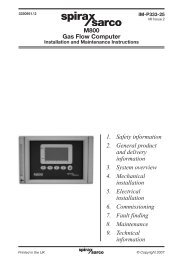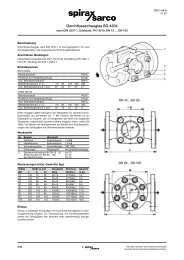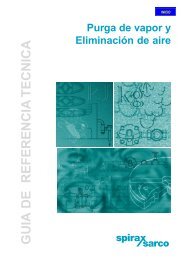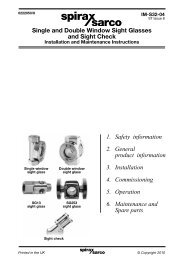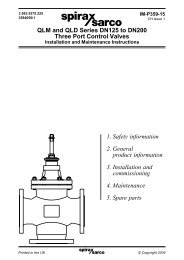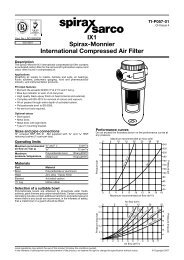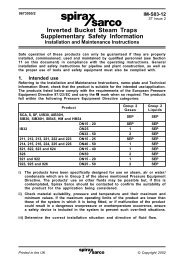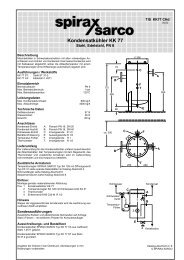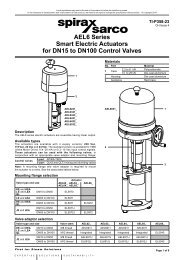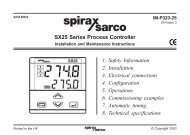2000 Hook-up Book - Spirax Sarco
2000 Hook-up Book - Spirax Sarco
2000 Hook-up Book - Spirax Sarco
You also want an ePaper? Increase the reach of your titles
YUMPU automatically turns print PDFs into web optimized ePapers that Google loves.
SYSTEM DESIGN<br />
18<br />
Steam Tracing<br />
A similar but maintainable<br />
type intended for use on instrument<br />
tracer lines, where the<br />
physical size of the trap is important<br />
as well as its operating<br />
characteristics is shown in Fig. 35.<br />
Just as the distribution of<br />
steam is from a common header,<br />
it often is convenient to connect a<br />
number of traps to a common<br />
condensate header and this simplifies<br />
maintenance. As noted, the<br />
discharge should preferably enter<br />
the header through swept connections<br />
and the headers be<br />
adequately sized as suggested in<br />
Table 8 (page 16).<br />
Figure 35<br />
Maintainable Balanced Pressure<br />
Tracer Trap.<br />
Case in Action: Product Steam Tracing with Temperature Control and Overheat Protection<br />
During steam tracing project design, it was found that five<br />
thousand feet of 2" product piping was to be traced with<br />
150 psig steam. Product temperature was to be maintained<br />
at 100°F, with maximum allowable temperature of 150°F<br />
and a minimum allowable temperature of 50°F.<br />
Of particular concern was the fact that the pipeline<br />
would always be full of the product, but flow would be<br />
intermittent. Overheating could be a real problem. In addition,<br />
the tracing system had to be protected from freezing.<br />
Solution<br />
The 5,000 feet of product piping was divided into 30 separate<br />
traced sections including: a cast steel temperature<br />
regulator, a bronze temperature control valve used as a<br />
high limit safety cutout, a sealed balanced pressure thermostatic<br />
steam trap, a vacuum breaker, and pressure<br />
regulators s<strong>up</strong>plying steam to all 30 tracing sections. Each<br />
section operates effectively at the desired temperature,<br />
regardless of flow rate or ambient temperature.<br />
These may be increased<br />
where high pressures and traps<br />
discharging condensate at near<br />
steam temperature are used, or<br />
decreased with low pressures<br />
and traps discharging cooler condensate.<br />
Temperature Control<br />
of Tracer<br />
Where it is essential to prevent<br />
overheating of the product, or<br />
where constant viscosity is<br />
required for instrumentation,<br />
automatic temperature control is<br />
frequently used.<br />
On many systems, the simplest<br />
way to achieve control is to<br />
use a reducing valve on the<br />
steam s<strong>up</strong>ply to the tracer lines or<br />
jacket. This can be adjusted in the<br />
light of experience to give the correct<br />
steam pressure to produce<br />
the required product temperature.<br />
Clearly this is an approximate<br />
way to control product temperature<br />
and can only be used where<br />
the product flow is fairly constant.<br />
Where closer control is required,<br />
the simple direct acting tempera-<br />
ture control often provides an<br />
economic solution. This will give<br />
close control and since it is not<br />
necessary to provide either electric<br />
power or compressed air, the<br />
first cost and indeed the running<br />
costs are low.<br />
Benefits<br />
• The chance of product damage from overheating is minimized<br />
and steam consumption is reduced through<br />
steam pressure reduction (150 psig to 50 psig) with the<br />
pressure regulator.<br />
• The product temperature is maintained at a consistent<br />
set temperature, maximizing process control under all<br />
flow conditions with the temperature regulator.<br />
• Product damage from overheating is prevented through<br />
use of the high limit safety cutout. The system will shut<br />
down completely, should the temperature regulator overshoot<br />
its set point.<br />
• The tracing system is protected from freezing with the<br />
sealed balanced pressure thermostatic steam trap discharging<br />
to drain. Thorough drainage is also facilitated<br />
by the vacuum breaker.



